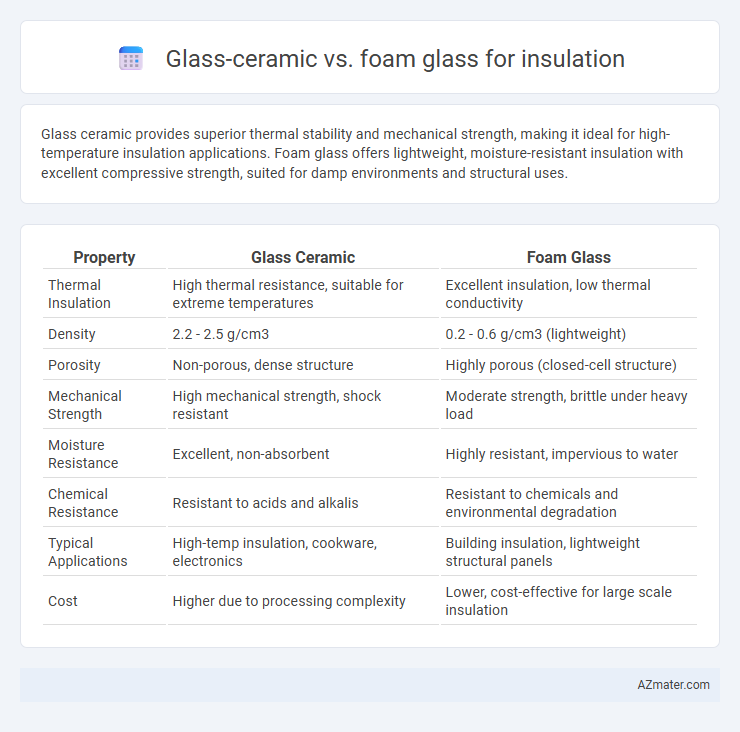Glass ceramic provides superior thermal stability and mechanical strength, making it ideal for high-temperature insulation applications. Foam glass offers lightweight, moisture-resistant insulation with excellent compressive strength, suited for damp environments and structural uses.
Table of Comparison
| Property | Glass Ceramic | Foam Glass |
|---|---|---|
| Thermal Insulation | High thermal resistance, suitable for extreme temperatures | Excellent insulation, low thermal conductivity |
| Density | 2.2 - 2.5 g/cm3 | 0.2 - 0.6 g/cm3 (lightweight) |
| Porosity | Non-porous, dense structure | Highly porous (closed-cell structure) |
| Mechanical Strength | High mechanical strength, shock resistant | Moderate strength, brittle under heavy load |
| Moisture Resistance | Excellent, non-absorbent | Highly resistant, impervious to water |
| Chemical Resistance | Resistant to acids and alkalis | Resistant to chemicals and environmental degradation |
| Typical Applications | High-temp insulation, cookware, electronics | Building insulation, lightweight structural panels |
| Cost | Higher due to processing complexity | Lower, cost-effective for large scale insulation |
Introduction to Glass Ceramic and Foam Glass Insulation
Glass ceramic insulation offers exceptional thermal stability and resistance to thermal shock due to its unique microstructure formed by controlled crystallization of glass. Foam glass insulation provides lightweight, non-combustible, and moisture-resistant properties, created by foaming crushed glass into a rigid cellular structure. Both materials excel in energy efficiency applications, with glass ceramic suited for high-temperature environments and foam glass ideal for lightweight, durable thermal insulation.
Material Composition and Manufacturing Processes
Glass ceramic insulation is composed primarily of silica, alumina, and other metal oxides, formed through controlled crystallization of molten glass, resulting in a dense, durable structure with fine crystalline phases. Foam glass insulation consists mainly of recycled glass that is crushed, powdered, mixed with a foaming agent, and then sintered to create a lightweight, porous material characterized by closed-cell glass bubbles. The manufacturing process of glass ceramics involves precise heat treatment for nucleation and crystal growth, whereas foam glass is produced by foaming the glass powder at high temperatures to achieve thermal insulation properties.
Thermal Insulation Properties Comparison
Glass ceramic exhibits superior thermal insulation properties due to its low thermal conductivity, typically around 0.04 W/m*K, making it effective in high-temperature environments. Foam glass also offers excellent insulation, with thermal conductivity values ranging from 0.03 to 0.07 W/m*K, but its cellular structure provides enhanced moisture resistance and compressive strength. Comparing both materials, foam glass is preferred for lightweight insulation applications requiring durability and moisture resistance, while glass ceramic is ideal for applications demanding higher thermal stability and temperature resistance.
Mechanical Strength and Durability
Glass ceramic insulation offers superior mechanical strength compared to foam glass, making it ideal for applications requiring high load-bearing capacity and resistance to impact. Foam glass, while slightly less strong, excels in durability due to its closed-cell structure, providing excellent resistance to moisture, chemicals, and thermal cycling. Both materials demonstrate long-term stability, but glass ceramic's enhanced mechanical properties make it preferable in structurally demanding environments.
Moisture Resistance and Water Absorption
Glass ceramic offers superior moisture resistance and minimal water absorption due to its dense, non-porous microstructure, making it highly effective in humid or wet environments. Foam glass insulation, while lightweight and resistant to fire and chemicals, has a porous structure that can absorb small amounts of water if not properly sealed. For applications demanding optimal moisture resistance and negligible water absorption, glass ceramic outperforms foam glass by maintaining insulation integrity and preventing mold or degradation.
Environmental Impact and Sustainability
Glass ceramic insulation demonstrates superior environmental sustainability due to its durability and recyclability, reducing waste and lowering carbon emissions over its lifecycle. Foam glass insulation, made from recycled glass, offers excellent thermal and moisture resistance but may have a higher embodied energy due to the foaming process. Both options contribute to sustainable building practices, yet glass ceramic's longer lifespan and greater potential for reuse provide a more environmentally favorable choice.
Fire Resistance and Safety Features
Glass ceramic offers superior fire resistance due to its ability to withstand extremely high temperatures without melting or emitting toxic fumes, making it an excellent choice for fireproof insulation. Foam glass provides good fire resistance as well, characterized by its non-combustible and self-extinguishing properties, but it may not tolerate as high temperatures as glass ceramic. Both materials are non-toxic and contribute to safety by preventing the spread of fire, with glass ceramic often preferred in applications demanding maximum thermal stability and fire safety.
Application Areas in Construction and Industry
Glass ceramic insulation excels in high-temperature applications, including furnace linings, kiln insulation, and thermal barriers in industrial ovens due to its superior heat resistance and mechanical strength. Foam glass insulation is widely used in building construction for thermal and acoustic insulation in walls, roofs, and floors, as well as in cold storage and refrigeration facilities because of its lightweight, moisture resistance, and excellent compressive strength. Both materials serve critical roles in energy efficiency and thermal management across diverse sectors, with glass ceramic favored for extreme heat environments and foam glass optimized for structural and moisture-sensitive applications.
Cost Effectiveness and Availability
Glass ceramic insulation offers superior thermal resistance and durability but typically comes with a higher price point, making it less cost-effective for large-scale projects. Foam glass insulation is more affordable and widely available, providing excellent moisture resistance and compressive strength, which enhances its practicality for diverse applications. Availability of foam glass in standard sizes often reduces lead times and shipping costs compared to the more specialized production of glass ceramic materials.
Choosing the Right Material: Key Considerations
Glass ceramic insulation offers superior thermal resistance and durability, making it ideal for high-temperature applications and environments requiring long-term stability. Foam glass insulation provides excellent compressive strength, moisture resistance, and lightweight properties, suitable for underground or damp conditions. Key considerations include application temperature, moisture exposure, structural load, and installation environment to select the most effective insulation material.

Infographic: Glass ceramic vs Foam glass for Insulation
 azmater.com
azmater.com